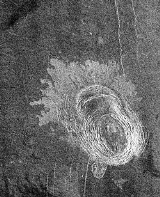
Sachs Patera
Encyclopedia
Sachs Patera is a feature on Venus
. Defined as a sag-caldera, Sachs is an elliptical depression 130 meters (81 feet) in depth, spanning 40 kilometres (24.9 mi) in width along its longest axis. The morphology implies that a chamber of molten material drained and collapsed, forming a depression surrounded by concentric scarps spaced 2 to 5 kilometers (1.2 to 3 miles) apart. The arc-shaped set of scarp
s, extending out to the north from the prominent ellipse, is evidence for a separate episode of withdrawal; the small lobe-shaped extension to the southwest may represent an additional event. Solidified lava flows 10 to 25 kilometers (6 to 16 miles) long give the caldera its flower-like appearance. The flows are a lighter tone of gray in the radar
data because the lava is blockier in texture and consequently returns more radar waves. Much of the lava, which was evacuated from the chamber, probably traveled to other locations underground, while some of it may have surfaced further south. This is unlike caldera
s on Earth
, where a rim of lava builds up in the immediate vicinity of the caldera.
Venus
Venus is the second planet from the Sun, orbiting it every 224.7 Earth days. The planet is named after Venus, the Roman goddess of love and beauty. After the Moon, it is the brightest natural object in the night sky, reaching an apparent magnitude of −4.6, bright enough to cast shadows...
. Defined as a sag-caldera, Sachs is an elliptical depression 130 meters (81 feet) in depth, spanning 40 kilometres (24.9 mi) in width along its longest axis. The morphology implies that a chamber of molten material drained and collapsed, forming a depression surrounded by concentric scarps spaced 2 to 5 kilometers (1.2 to 3 miles) apart. The arc-shaped set of scarp
Scarp
-Landforms and geology:* Cliff, a significant vertical, or near vertical, rock exposure* Escarpment, a steep slope or long cliff that occurs from erosion or faulting and separates two relatively level areas of differing elevations...
s, extending out to the north from the prominent ellipse, is evidence for a separate episode of withdrawal; the small lobe-shaped extension to the southwest may represent an additional event. Solidified lava flows 10 to 25 kilometers (6 to 16 miles) long give the caldera its flower-like appearance. The flows are a lighter tone of gray in the radar
Radar
Radar is an object-detection system which uses radio waves to determine the range, altitude, direction, or speed of objects. It can be used to detect aircraft, ships, spacecraft, guided missiles, motor vehicles, weather formations, and terrain. The radar dish or antenna transmits pulses of radio...
data because the lava is blockier in texture and consequently returns more radar waves. Much of the lava, which was evacuated from the chamber, probably traveled to other locations underground, while some of it may have surfaced further south. This is unlike caldera
Caldera
A caldera is a cauldron-like volcanic feature usually formed by the collapse of land following a volcanic eruption, such as the one at Yellowstone National Park in the US. They are sometimes confused with volcanic craters...
s on Earth
Earth
Earth is the third planet from the Sun, and the densest and fifth-largest of the eight planets in the Solar System. It is also the largest of the Solar System's four terrestrial planets...
, where a rim of lava builds up in the immediate vicinity of the caldera.

